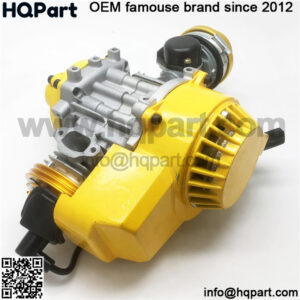What is a car engine and how does it work?
Prior to hybrid and electric-powered vehicle engines, a car’s engine could easily be described as a machine that facilitates the internal combustion of energy-producing liquids like diesel and petrol. However, since the introduction of hybrid and electric cars, explaining how a modern car engine works requires a bit more information and know-how.
In 2021, modern vehicle engines can be more easily understood once divided into their three primary categories, which include:
- Internal combustion engines
- Hybrid engine (Internal combustion engine + electric engine)
- Electric engine
In this article, we’re focusing on the workings of the traditional internal combustion engine and review the most common type of combustion engines used in vehicles today.
How does the internal combustion engine work?
To understand the steps of how a four stroke internal combustion engine works, the following expression is often used: Suck, Squeeze, Bang, Blow.
This phrase encompasses the four primary actions a four-stroke engine must accomplish to convert liquid fuel into usable energy. The energy produced by this cycle is what ultimately pushes the vehicle forward.
Suck, Squeeze, Bang, Blow
A description of how all of the different types of car engines that utilize a four-stroke engine works can be described in the following four steps.
Step 1: Suck
Basic: The engine sucks in a mixture of fuel and air.
The piston starts the process by descending and drawing air into the cylinder via intake valves. Then, fuel is delivered into a cylinder that houses the piston. This is what is referred to as an intake stroke.
Step 2: Squeeze
Basic: The engine compresses, or squeezes, the air and fuel in the cylinder.
The intake valve’s close allowing the piston to move back up, thereby compressing the air and fuel within the cylinder.
Step 3: Bang
Basic: The compressed fuel and gas explodes with use of a catalyst.
A spark plug ignites the compressed fuel/air mixture to create a small explosion. The process is repeated continuously when the engine is running. The energy released from these micro-explosions is channeled to the vehicle’s wheels.
Step 4: Blow
Basic: Exhaust goes out.
The waste fumes produced by the explosion in each cylinder are expelled through the vehicle’s exhaust system.
Regular vehicle maintenance is critical for a vehicle’s engine to be able to perform well and last as long as possible.
Different Internal Combustion Engine Configurations
In modern engines, the cylinders are arranged in different ways and configurations to give off different results. Your car engine will either have an inline, V, or rotary cylinder configuration. Each type of configuration has its own benefits and drawbacks which we will discuss below.
V Style Engines
This used to be the most common car engine on the market and is still heavily used by car manufacturers today.
It features two collections of cylinders that are positioned to the crankshaft at an angle that forms a “V” shape. These configurations come in three variants: V6, V8 and V12. These engines have a collection of 3, 4 or 6 cylinders on either side.
V Engines Pros and Cons:
- V type engines usually boast of high-quality engine displacement and a rigid design.
- They are expensive to maintain and complex for people to understand.
- Compact and allows for more cabin space.
- Ideal for larger family vehicles, trucks, and other automobiles where greater power and towing capacity is required.
Examples of vehicles commonly found in our inventory section with V-style engines include:
- Ford Expedition
- Honda Ridgeline
- Ford F-150
- Honda Odyssey
Inline Engines
The inline style of engine configuration is characterized by having all cylinders in a straight line. The pistons rotate 360 degrees in such engines. The first mass produced vehicle, the Model-T by Ford, relied on an inline 4 cylinder engine from 1908 – 1927.
Modern day inline engines are more compact, fuel efficient and perform better than the original Model T’s version. Vehicles with 3 or 4 cylinder engines will most likely have inline engines. Some examples of great, quality used vehicles that have inline engines are:
- Mitsubishi Mirage
- Honda Accord
- Buick Regal
- Chevrolet Cruze
Pros and Cons of an Inline Engine
- These engines are compact and lightweight.
- They are easy to fix.
- They are rather delicate engines.
When shopping for a used sedan, compact, or fuel-efficient vehicle, you should expect to find one with a 4-cylinder inline engine. Their compact size, lightweight materials, and good fuel efficiency make them ideal for powering smaller sized passenger vehicles.
Flat engines
These engines share similar characteristics to the V style engines and are often referred to as boxer engines. The main difference is that the cylinders are placed at a 180-degree angle from each other. Flat engines provide a low centre of mass and are most commonly seen by Victoria car buyers in motorcycles and high-end luxury vehicles.
Motorcycles, such as ones made by BMW in 2021, largely rely on two-cylinder flat engines.
High-performance vehicles with flat engines have included the JaguarXK6,
Pros and Cons of Flat Engines
- Vehicles with flat engines are well balanced and easy to handle.
- They can be huge engines and rather complex to understand.
Rotary Engines
This engine configuration is common in aircrafts and very few cars. A rotary engine has a single crankshaft placed at the centre of pistons that move in a star pattern rather than the usual upwards and downwards movement.
Pros and Cons of Rotary Engines
- These engines are simple to understand.
- They are durable engines.
- Very hard to find skilled mechanics in case of failure.

